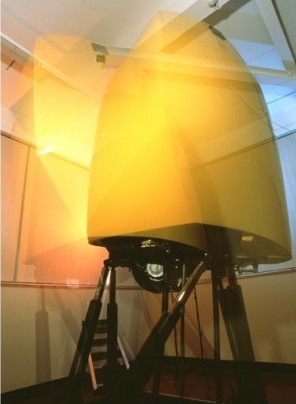
Flight Science & Technology Research Group
Prospective SkyGuides in Helicopter NoE Flight
Department Home
Page
Courses
Simulation
Facilities
Feedback: mdw@liv.ac.uk
 Helicopter
pilots make use of nap-of-the-Earth (NoE) flight to increase
stealth and mission security.
Such tactical flight, close to the ground and amongst the
surrounding obstacles, is characterised by the pilot making
continuous corrections in speed, height and heading, guided by a
mental model of where his or her aircraft will be in the future.
The pilot uses what can be described as ‘prospective
control’ to evolve a safe trajectory, or skyway, based on
perception of the aircraft’s changing velocity and direction from
instant to instant. How
far into the future this mental model needs to project is a central
question for research into vision aids, the answer to which depends
on the task being flown and, critically, on the aircraft’s
performance and handling qualities.
For NoE tasks, turning through a terrain-gap, stopping in a
clearing or climbing over a hill, there is clearly a requirement
for an adequate flight safety margin
Helicopter
pilots make use of nap-of-the-Earth (NoE) flight to increase
stealth and mission security.
Such tactical flight, close to the ground and amongst the
surrounding obstacles, is characterised by the pilot making
continuous corrections in speed, height and heading, guided by a
mental model of where his or her aircraft will be in the future.
The pilot uses what can be described as ‘prospective
control’ to evolve a safe trajectory, or skyway, based on
perception of the aircraft’s changing velocity and direction from
instant to instant. How
far into the future this mental model needs to project is a central
question for research into vision aids, the answer to which depends
on the task being flown and, critically, on the aircraft’s
performance and handling qualities.
For NoE tasks, turning through a terrain-gap, stopping in a
clearing or climbing over a hill, there is clearly a requirement
for an adequate flight safety margin
In
engineering terms, the positional states and motion velocity and
turn rate describe the flight control task.
The pilot effectively transforms perceived motion in the
optical frame of reference into relative motion in the inertial
frame-of-reference and applies feedback regulation to minimise
errors between the commanded and perceived motion.
In an alternative, active psychophysics framework, flight
control can be described in terms of pilots picking up information
generated by motion over terrain and around obstacles, through
variables in the optical flow-field from the surfaces in their
field of vision.
Optical
flow rate can, for example, provide the pilot information on ground
speed in eye-heights per second or surface slant.
Another optical variable is that which specifies the time to
contact or close to an obstacle or surfaces at the current closing
rate – tau.
Tau provides a temporal scaling of the external environment and,
like other flow-field variables, provides pilots with instinctive
information about their motion relative to external surfaces.
More recent developments of tau theory have hypothesised
that purposeful motion is guided by couplings arising from either
external or internal sources.
This hypothesis will feature as a central theme in the
research.
General Tau-theory applies to gap closure using any form of sensory input. The pilot picks up information from the visual scene, allowing them to co-ordinate and synchronise motions. This synchronisation is achieved by keeping the Taus of the motion gaps (say X and Y) coupled in constant ratio.
A
number or studies have already investigated, and reported on, the
first use of optical tau in flight and these will form the basis of
the research for the project.
A specific focus will be the potential use head-up displays in civil helicopter operations and the design of tau-based display formats. Areas of innovation will include:
-
Develop tau theory to include novel intrinsic guides and coupling techniques
-
Apply tau theory to understand how pilots use visual information in visually deprived situations (accident scenarios will be used as a basis)
-
Apply tau theory to understand how pilots use visual information Develop tau-based HUD formats
Members: